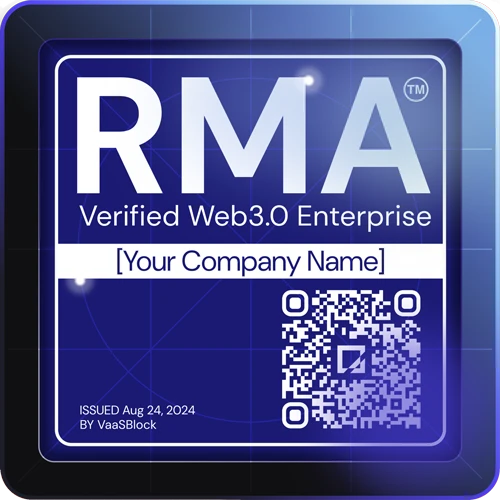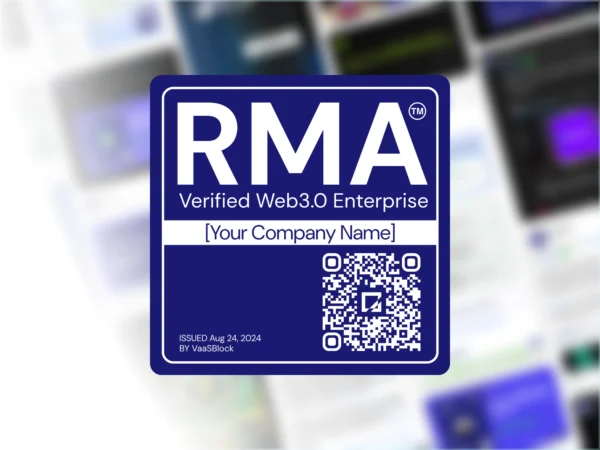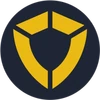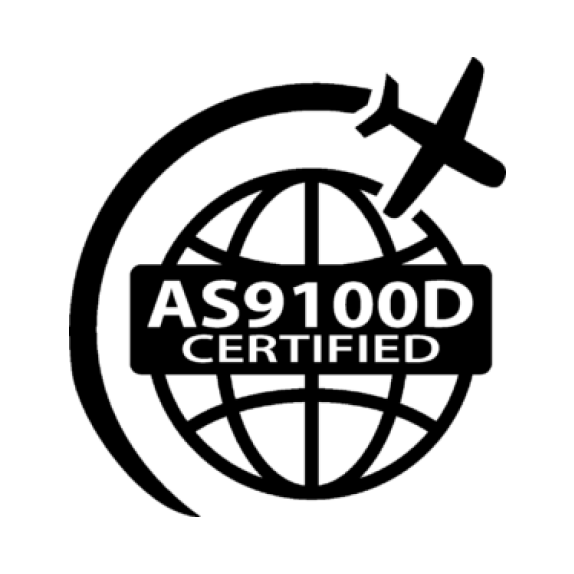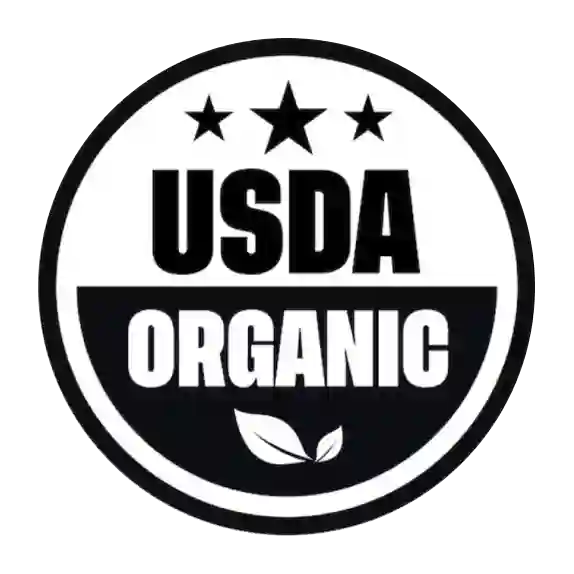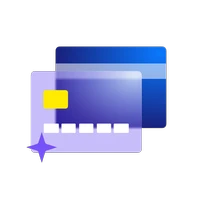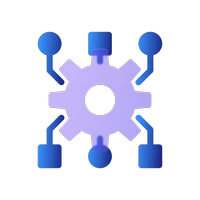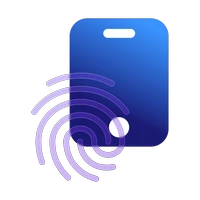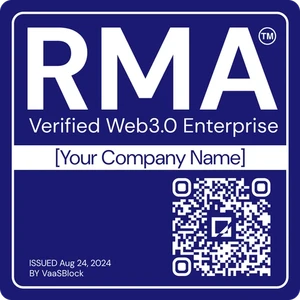
RMA™ Badge — The self-assessment verification for legit Web3 Organizations.
Tailored for Web3 projects, neo-tech builders and organizations supporting blockchain initiatives, the RMA™ certification evaluates six major Criteria to deliver Proof-of-Excellence badges.
As a trusted symbol of legitimacy, the RMA™ badge stands among the World’s leading accreditations, enabling investors, partners, and stakeholders to assess governance, technology, and operations in Web3 projects.
RMA™ is made strong by the companies who hold one.
We are honored to receive the RMA™ badge from VaaSBlock. This recognition validates our commitment to maintaining the highest standards in our research and consulting practices
Partnering with VaaSBlock and earning the RMA badge is a testament to our team’s dedication to excellence and security. We’re thrilled to be recognized alongside the best and are more motivated than ever to deliver a game that players will love.
We are thrilled to partner with VaaSBlock to enhance trust and transparency in the Web3 space. This strategic alliance underscores our commitment to elevating industry standards and supporting projects that prioritize credibility
We’re honored to be recognized for our achievements in securing the Web3 space. We’re committed to breaking down that barrier by providing the tools and solutions necessary to ensure that DeFi can thrive securely and sustainably.
RMA™ is the Industry Standard for Web3.
You’re 7 days away from announcing your RMA™.
Without disrupting your team’s regular workflow, 98% of companies successfully complete the RMA verification and announce their badge within 7 days.
2. Workshop
Someone from your team attends a 45-min Workshop to clarify and complete any gaps.
3. RMA™ Badge Mint
If standards are met, VaaSBlock issues the RMA™ badge.
4. Social Media Actions
We coordinate announcements and marketing actions with the right people in your team.
🎙 Mini-Podcast invitation
Our team tapes the week following the announcement, with the relevant speakers.
🌐 Access the RMA™ Network
Reap the rewards of being an RMA™ verified Organization.
16 Organizations started the RMA journey yesterday
Book your 30-min Exploration Call now
and Join the 1603+ Organizations holding an RMA badge.
Eligible Organizations
Any business working with – or supporting – blockchain and neo-web are RMA™ eligible.

Experiences
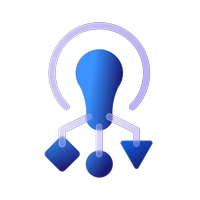
Logistics
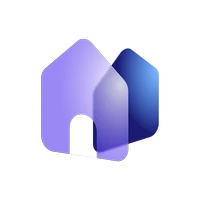
Real-World Assets
(RWA)
…and more.
Only 3% of Web3 Organizations get the RMA™ certification on their first attempt.
VaaSBlock helps you meet compliance minimas to build serenely the future of your company.
What verification does it cover?
The RMA™ certification is adaptable to your Organization’s unique positioning and fully comprehensive of all Web3 specificities.
Corporate Governance
Seek to understand the corporate structure and banking history.
Corporate Governance
Seek to understand the corporate structure and banking history.
The Corporate Governance component of the RMA™ audit offers a comprehensive evaluation of a company’s leadership and operational frameworks, tailored specifically for the Web3 ecosystem. The auditors aim to verify fundamental governance and organizational structure, including verifying the entity’s legal registration and compliance within its jurisdiction ensuring adherence to local laws and regulations. The audit examines the company’s banking history and creditworthiness, confirming transparent and reliable financial practices.
In the Web3 landscape, fundraising can occur through traditional share raises and token sales. The RMA™ audit scrutinizes the fundraising history, ensuring that all capital raised—whether through equity or tokens—is well-documented and compliant with regulatory standards. If the raise is done through tokens, the auditors will challenge the tokenomics and seek out risks such as vesting periods that may later hurt the organization’s reputation with a broader pool of stakeholders. This dual approach ensures organizations maintain transparency and accountability in diverse funding methods.
The audit assesses the governance structure, evaluating the composition and effectiveness of the board of directors, management accountability, and the independence of key leadership roles. It ensures that the legal structure aligns with the company’s business activities, growth stage, and operational regions, promoting sustainable growth and adaptability. Ethical standards and business practices are also reviewed, reinforcing the company’s commitment to integrity and responsible management. Companies will provide a variety of documentation to meet these standards.
Revenue Model
Understand the current and expected financial performance.
Revenue Model
Understand the current and expected financial performance.
The Revenue Model component of the RMA™ audit comprehensively evaluates a company’s income-generating strategies (how do they make or intend to make money), ensuring financial robustness and sustainability. The auditors begins by understanding the organization’s revenue streams, whether derived from product sales, subscription sales, transaction fees, token sales, or other innovative models. To pass these criteria of the RMA™, justification must be provided allowing a complete understanding of current and long-term viability, plus strategies to adjust to external factors, changing market conditions, consumer behavior, and competition.
The RMA™ audit questions the organization’s readiness for varying market conditions, most notably as bear and bull markets, which is particularly important for products or services relying on a certain market condition. The audit identifies the financial controller responsible for overseeing the revenue streams, managing financial performance, and maintaining accurate accounts. This includes verifying the effectiveness of financial controls and performance reporting mechanisms in place.
Additionally, the auditors seeks justification to ensure that the revenue model aligns with the company’s current growth stage and future expansion plans. They evaluate the balance between revenues received in cryptocurrency and FIAT, and scrutinize the measures taken to safeguard funds against market volatility. Beyond income streams, the organization can provide stability via assets and cash, a common and acceptable situation for most early companies. By ensuring that revenue strategies are well-structured and secure, the RMA™ certification enhances credibility and stakeholder confidence, reinforcing the organization’s standing as a responsible and trustworthy entity more likely ready for sustainable growth.
Technology and Security
Demonstrate appropriate levels of security for their business.
Technology and Security
Demonstrate appropriate levels of security for their business.
The Technology and Security component of the RMA™ audit offers a comprehensive evaluation of a company’s technical infrastructure and security protocols, ensuring robust protection and operational resilience. This part of the audit assesses the organization’s technological framework, including blockchain integrations (where relevant), system architecture, and overall IT infrastructure. It verifies that the codebase adheres to industry best practices, emphasizing quality, scalability, and efficiency.
A pivotal aspect of this component is the requirement for comprehensive security measures. While RMA™ does not perform smart contract audits directly, it mandates that projects undergo rigorous third-party security assessments, such as those conducted by Hashlock and Certik. RMA™ then reviews these results within the company’s broader technical and business landscape. Additionally, projects holding certifications like SOC2 and ISO 27001 are highly encouraged to submit these credentials, as they demonstrate a strong foundation in security and operational controls and are viewed favorably during the audit. VaaSBlock values established industry standards highly, and auditors generally need to gather less information when presented with trusted certifications.
The audit examines the implementation of advanced security measures, including encryption protocols, multi-factor authentication, secure key management, and incident response strategies to safeguard user data and assets. It also evaluates the organization’s risk and crisis management practices, including bounty programs that incentivize vulnerability reporting. By ensuring that technology and security practices are both robust and adaptable, the RMA™ certification underscores a company’s dedication to maintaining a secure and trustworthy platform, enhancing credibility and fostering lasting trust among users, investors, and stakeholders.
Planning and Transparency
Understand the daily operations and planning.
Planning and Transparency
Understand the daily operations and planning.
The Planning and Transparency component of the RMA™ audit offers a thorough assessment of how an organization manages its workflow and prepares for unexpected challenges a business might encounter, plus the additional risks of the Web3 ecosystem. This audit examines the company’s operational frameworks, organizational charts, project management tools, including relevant resources such as visual snapshots of Kanban boards or workflow diagrams. Documentation that illustrates how tasks are created, tracked, and completed is reviewed to ensure the organization employs efficient and transparent processes to deliver its products or services.
A critical aspect of this evaluation is the organization’s ability to plan for and respond to black-swan events. RMA™ auditors assess the robustness of crisis management strategies, including the roles and responsibilities of key personnel during emergencies. This includes reviewing templates for customer communication (if relevant) in the event of data breaches, ensuring that the company is prepared to assist clients promptly and effectively if issues arise. The audit examines whether the organization conducts regular drills and simulations to test its readiness for various crisis scenarios, reinforcing its capability to handle disruptions without compromising security or service quality.
By evaluating both the structured planning processes and the transparency in operational execution, the Planning and Transparency audit under RMA™ confirms that organizations are well-prepared to maintain continuity and trust, even in the face of unexpected challenges.
Team Profficiency
Ensure the team is up to the task today and built for the future.
Team Profficiency
Ensure the team is up to the task today and built for the future.
The Team Proficiency component of the RMA™ audit thoroughly evaluates an organization’s personnel, ensuring that crucial team members possess the expertise and dedication necessary to execute current business models and scale effectively within the Web3 ecosystem. This audit delves into the backgrounds of founders, executives, and core team members, verifying that their professional histories align with the project’s objectives and demonstrate a track record of success in similar ventures.
A critical aspect of this evaluation is assessing the commitment of key personnel. RMA™ auditors scrutinize the dedication of founders and departmental leaders, ensuring they are fully engaged and unlikely to abandon the project prematurely—a common challenge in the Web3 space. The audit also examines the educational backgrounds and practical experiences of team members, confirming that they have the qualifications and adaptability to grow alongside the rapidly evolving blockchain industry.
Beyond resumes and LinkedIn profiles, RMA™ auditors conduct in-depth interviews and reference checks to understand each individual’s capabilities and commitment. Additionally, the audit evaluates the expertise and backgrounds of advisors, confirming they provide valuable guidance and support. Ensuring that the team is highly qualified and deeply committed, the Team Proficiency audit reinforces the organization’s capacity to sustain growth and long-term success, thereby enhancing trust among investors and stakeholders.
Results Delivered
Understand the speed the organization is progressing.
Results Delivered
Understand the speed the organization is progressing.
The Results Delivered component of the RMA™ audit comprehensively evaluates an organization’s ability to achieve its goals and honor its commitments. It focuses on the success and track record of a company’s completed projects, emphasizing tangible outcomes that align with stated objectives. RMA™ auditors meticulously review key performance indicators (KPIs), project milestones, and the overall impact of the organization’s products or services on the market.
Importantly, RMA™ acknowledges that targets may not always be met for valid reasons. Auditors explore what the company has learned from meeting and missing targets, ensuring that adjustments are logical and justified. This approach confirms that organizations remain honest and capable of validating their performance, enhancing trust among investors and stakeholders.
A pivotal focus is on validating claims made during fundraising, partnerships, and marketing efforts. Auditors ensure that the company has fulfilled its promises to stakeholders, such as meeting revenue targets, completing product development on schedule, or securing strategic partnerships. Metrics like user adoption rates, transaction volumes, and community engagement are closely analyzed to assess actual performance against expectations. Additionally, the audit examines the frequency and reliability of code releases, ensuring regular updates without causing system downtime, which is crucial for maintaining user trust and platform stability.
The audit also evaluates the organization’s partnership track record, favoring companies that consistently form alliances with larger, reputable businesses. Understanding who is responsible for managing partnerships within the company provides insight into the effectiveness and strategic alignment of these collaborations. Furthermore, auditors assess whether the company’s announced goals are ambitious and substantial enough to drive significant growth and innovation.
The RMA™ Benefits
The RMA™ Benefits
for Builders
✔ Unlock Marketing & PR Opportunities
✔ Fast-track Exchange Listings
✔ Enhance Confidence with Investors and VCs
✔ Fortify Community credibility
✔ Attract top Talent with trusted Credentials
for Service Providers
✔ Facilitated Deal-flow to builders
✔ Elevate Brand prestige
✔ Amplify visibility through strategic PR
✔ Additional Sales argument against competitors
✔ Stand among legitimate Organizations in Web3
Learn more about the RMA™
How long does the RMA™ Certification process take?
The duration varies by project complexity. Typically, the process takes 8-12 weeks. Projects with prepared documentation and strong governance practices may see a shorter timeline.
What costs are associated with obtaining RMA™ Certification?
Fees are determined based on project size and complexity. For detailed pricing, contact VaaSBlock to receive a customized quote.
How does RMA™ Certification differ from other certifications like SOC2?
SOC2 focuses on data security within centralized systems, while RMA™ offers a broader evaluation covering governance, transparency, and operational aspects tailored for blockchain projects.
Can a project lose its RMA™ Certification?
Yes, projects are subject to periodic reviews to maintain compliance. If a project fails to meet certification standards during these reviews, the RMA™ badge can be suspended or revoked.
How does RMA™ Certification impact partnerships with traditional financial institutions?
RMA™ Certification validates a project’s governance and security, reducing perceived risks for traditional financial institutions. This fosters trust, making it easier to form partnerships and attract institutional investments.
Should non-technical or supporting projects like marketing agencies or consultants also seek RMA™ Certification?
Yes, agencies, consultancies, and other service providers working with blockchain projects should seek RMA™ Certification. This helps validate their expertise, credibility, and commitment to best practices, making them more attractive partners for crypto and blockchain projects.
What criteria are audited to evaluate a company?
The RMA™ (Risk Management Authentication) badge is a certification awarded by VaaSBlock to blockchain organizations that meet stringent standards across multiple key areas of their operations. This badge signifies that an organization has undergone a comprehensive annual review, meticulously assessing the following six categories:
- Corporate Governance: Examining the corporate structure, banking history, and funding details to understand the governance framework under which the organization operates.
- Revenue Model: Analyzing the current and projected financial performance to gauge the economic viability and sustainability of the organization.
- Planning and Transparency: Reviewing daily operations, strategic planning, and crisis management protocols to ensure preparedness and clarity in operations.
- Results Delivered: Evaluating the progress speed of the organization, including partnerships with major entities and the timeliness of project delivery.
- Team Proficiency: Assessing team capabilities, awareness of gaps, and legitimacy of background to confirm they are well-equipped for present and future challenges.
- Technology and Security: Ensuring that the technical setup and security measures are robust and appropriate for the specific nature of the business.
The RMA™ certification is tailored to the nature and stage of each organization, considering factors like whether they’re a startup or a more established entity. For instance, a blockchain-based project might be required to present smart contract audits, while a marketing agency would need to demonstrate how they secure customer data and maintain password safety.
Earning the RMA™ badge distinguishes organizations in the competitive blockchain space by providing evidence to investors, partners, and users of their commitment to excellence and reliability. This certification not only boosts an organization’s credibility but also enhances stakeholder confidence, facilitating smoother operations, investments, and collaborations.
What types of Organizations are RMA eligible?
The RMA™ certification is designed to serve a wide range of organizations within the blockchain ecosystem. Eligible entities include:
- Blockchain Startups: New companies seeking to establish credibility and attract early-stage investors and partners.
- Established Blockchain Enterprises: More mature organizations looking to reinforce their market position and validate their operational integrity.
- Web3 Service Providers: Entities that offer services such as technology solutions, marketing, consulting, and more, all of whom benefit from demonstrating a high standard of professional conduct and security.
- Financial Institutions and Exchanges: These organizations can certify their blockchain-related services, ensuring they meet high security and compliance standards.
- Non-Profit Organizations: Non-profits operating within the blockchain space, aiming to show transparency and accountability to donors and stakeholders.
- Educational Institutions: Schools and universities that provide blockchain education and need to validate the quality and safety of their programs.
By catering to this diverse range of organizations, the RMA™ certification helps to elevate standards across the entire blockchain industry, ensuring that entities of all types and sizes can establish trust and achieve sustainable growth.
How can I verify the authenticity of an RMA™ badge?
Verifying the authenticity of an RMA™ badge is straightforward and ensures that you are engaging with a credible and trustworthy blockchain organization. Each RMA™ badge is minted as a unique digital token that includes a specific QR code linked to detailed certification information. To verify an RMA™ badge, follow these steps:
- Scan the QR Code: Use any standard QR code scanner to access the unique link embedded in the badge.
- Check the Digital Wallet: The link should direct you to a VaaSBlock digital wallet that hosts the tokenized badge. Verify that the wallet address matches the one publicly listed by VaaSBlock as authentic.
 vaasblock.eth — 0xaf5b883c2a433BB8aC6175F71698f78108528359 — See on
vaasblock.eth — 0xaf5b883c2a433BB8aC6175F71698f78108528359 — See on  Opensea
Opensea vaasblock.base.eth — 0xaf5b883c2a433BB8aC6175F71698f78108528359 — See on
vaasblock.base.eth — 0xaf5b883c2a433BB8aC6175F71698f78108528359 — See on  Opensea
Opensea vaasblock.ton — UQBZlzQ5Uq8qmmsKwgc3R9ekAPcqoPgRmXrmcs12aq1Be4Co — See on
vaasblock.ton — UQBZlzQ5Uq8qmmsKwgc3R9ekAPcqoPgRmXrmcs12aq1Be4Co — See on  Tonviewer
Tonviewer - Review the Badge Details: Ensure that the details on the tokenized badge match those publicly displayed by the organization and VaaSBlock. This includes the certification validation date and project name. It is important to ensure all these match with what is claimed in the orginal location where you saw the RMA™ badge.
Thanks to blockchain technology, the authenticity of the badge cannot be faked, unlike traditional industry certifications. This secure method of verification highlights the real-world utility of blockchain for ensuring the integrity and credibility of certifications. By confirming these elements, you can be assured of the badge’s legitimacy.
What are the marketing benefits of the RMA™ Certification?
Organizations with the RMA™ have recieved statstically significant results compared to peers across multiple channels and are 60% more likely to survive as a business in the long term. How companies utilize their certification plays a major part in the benefits it can bring across and our team will advise you of opportunities and ideas relevant to your organization and the market at the time. An example of excellence would be 11 International using the RMA™ annoucement as an onboarding tool to wikipedia or Hakflow’s promanent usage of the NCNG podcast to promote their audits.
How does RMA™ Certification enhance a project’s appeal in the market?
The certification distinguishes projects by validating their compliance with industry standards. It demonstrates a project’s commitment to transparency, governance, and security, making it a compelling choice for users, investors, and partners.
What is the review frequency for RMA™ Certification?
RMA™-certified projects undergo an annual review to ensure they continue to meet the high standards required for certification. These reviews may include updated documentation submissions, interviews, and technology audits.
Demonstrate your trustability and accelerate your Organization’s growth
